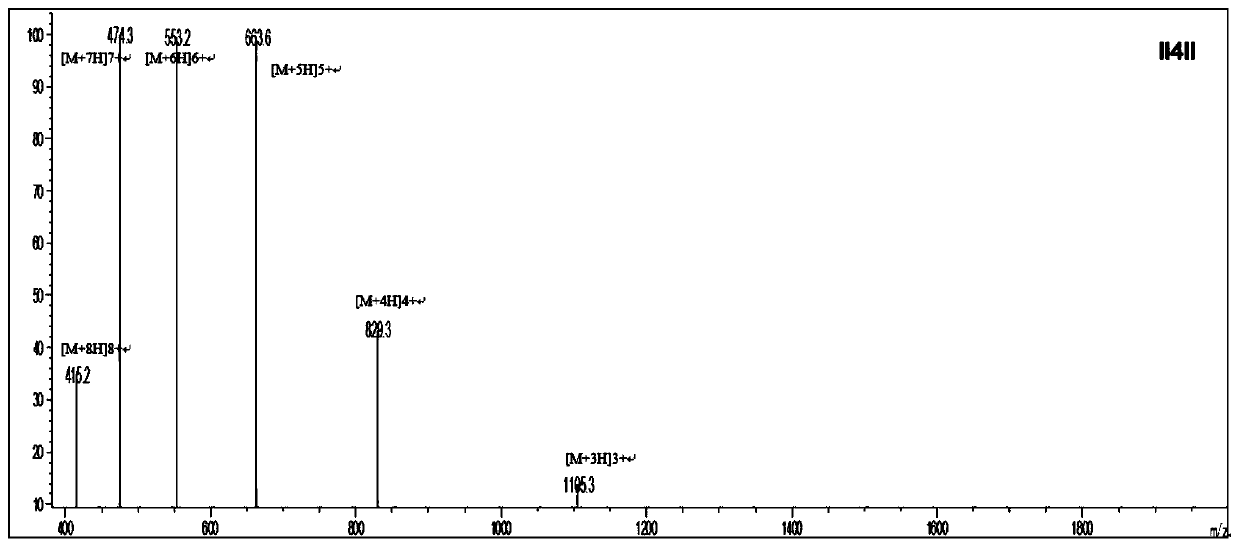Anti-enzymolysis antibacterial peptide II4II and preparation method and application thereof
An antibacterial peptide, anti-enzymatic hydrolysis technology, applied in the direction of antibacterial drugs, chemical instruments and methods, medical preparations containing active ingredients, etc. The effect of enzymatic hydrolysis ability and strong anti-enzymatic hydrolysis ability
- Summary
- Abstract
- Description
- Claims
- Application Information
AI Technical Summary
Problems solved by technology
Method used
Image
Examples
Embodiment 1
[0016] Design of Antimicrobial Peptides Against Enzyme
[0017] (1) Arg with high cationicity is selected as the cationic amino acid to provide the necessary net positive charge. In order to avoid the cleavage of Arg by trypsin, Cys and Lys were placed on the N-terminal side and C-terminal side of Arg, respectively, to block the cleavage of Arg by trypsin. At the same time, Pro was placed on the C-terminal side of Lys to block the cleavage of Lys by trypsin.
[0018] (2) In order to avoid cleavage by chymotrypsin and pepsin, Ile with a longer aliphatic side chain was selected as the hydrophobic amino acid and placed on the C-terminal side of Pro and the N-terminal side of Cys to provide the necessary hydrophobicity.
[0019] (3) Place two Ile respectively at the N-terminus and C-terminus of the sequence unit to enhance the hydrophobicity to further improve the activity.
[0020] The anti-enzymolytic antimicrobial peptide template is thus designed as: XX(XCRKPX)nXX-NH 2 , wh...
Embodiment 2
[0027] Synthesis of Antimicrobial Peptides by Solid Phase Chemical Synthesis
[0028] 1. The synthesis of antimicrobial peptides is carried out one by one from the C-terminal to the N-terminal by a peptide synthesizer. First, Fmoc-X (X is the first amino acid at the C-terminal of each antimicrobial peptide) is inserted into Wang resin, and then the Fmoc group is removed to obtain X-Wang resin; then Fmoc-Y-Trt-OH (9 -Fmoxy-trimethyl-Y, Y is the second amino acid at the C-terminus of each antimicrobial peptide); according to this procedure, it is synthesized from the C-terminus to the N-terminus until the synthesis is completed, and the side of the Fmoc group is removed chain protection resin;
[0029] 2. Add a cleavage reagent to the peptide resin obtained above, react for 2 hours at 20°C in the dark, filter; precipitate TFA (trifluoroacetic acid) and wash, then mix the washing liquid with the above filtrate, concentrate with a rotary evaporator, and then add About 10 times t...
Embodiment 3
[0033] Determination of Biological Activity of Antimicrobial Peptides
[0034] 1. Determination of antibacterial activity: The minimum inhibitory concentration (MIC) of the peptide was determined by the standard micro-broth dilution method. Dilute bacteria in log phase to 10 5 CFU / ml. Add 50 μl of different concentrations of peptides (the final concentration of the peptide is 1-128 μM) and an equal volume of bacterial suspension to each well of a 96-well plate, and set up a negative control (medium only) and a positive control (bacteria and medium) at the same time , and then place the 96-well plate in a constant temperature incubator at 37°C for 18-20 hours. Using a microplate reader at 492nm (OD 492 ) to determine the minimum inhibitory concentration. Three independent replicates were performed, with two parallels for each replicate. The results are shown in Table 2.
[0035] Bacteriostatic activity (μM) of table 2 antimicrobial peptides
[0036]
[0037]
[003...
PUM
 Login to View More
Login to View More Abstract
Description
Claims
Application Information
 Login to View More
Login to View More - R&D
- Intellectual Property
- Life Sciences
- Materials
- Tech Scout
- Unparalleled Data Quality
- Higher Quality Content
- 60% Fewer Hallucinations
Browse by: Latest US Patents, China's latest patents, Technical Efficacy Thesaurus, Application Domain, Technology Topic, Popular Technical Reports.
© 2025 PatSnap. All rights reserved.Legal|Privacy policy|Modern Slavery Act Transparency Statement|Sitemap|About US| Contact US: help@patsnap.com



